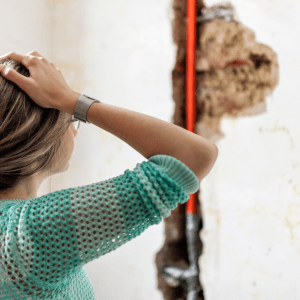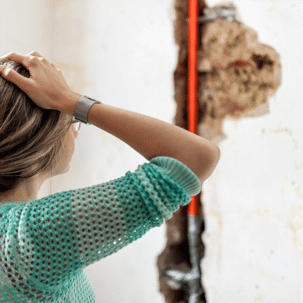Exposed plumbing pipes, whether in the bathroom, kitchen, or living spaces, can sometimes be an eyesore. They can disrupt the flow of your interior design and can often become a dust magnet. If you’ve been pondering how to conceal plumbing pipes or simply how to cover up plumbing pipes for a cleaner look, this guide is here for you. Let’s dive into some innovative yet straightforward methods to elevate your space.

1. Use Decorative Boxing
Decorative boxing is a time-tested technique for concealing pipes in both bathrooms and kitchens. This involves constructing a box made of materials like wood or MDF around the pipes, effectively hiding them from view. Once constructed, the box can be painted, stained, or otherwise finished to match the surrounding walls, cabinetry, or decor, offering a seamless, built-in look. Besides hiding the plumbing, decorative boxing can also create a cleaner, more streamlined aesthetic, making it a win-win for style and function.
2. Place Furniture and Fixtures
An imaginative way to obscure pipes involves strategically placing furniture or fixtures in their vicinity. Whether it’s a tall potted plant, a well-placed bookshelf, or even a captivating piece of artwork, these items can serve to distract the eye from unsightly plumbing. This method is especially helpful for masking pipes in communal spaces like living rooms or dining areas, transforming a potential eyesore into a focal point of design interest.
3. Paint Them
For minimalists who prefer a less-is-more approach, painting the exposed pipes to blend with the walls can be a simple but effective strategy. Prior to painting, ensure the pipes are clean and free from rust. Choose a paint that is appropriate for the material of the pipes and the humidity levels of the room. By matching the paint color to the surrounding walls, the pipes can virtually disappear into the background.
4. Consider Flexible Covers
Flexible pipe covers offer a quick and easy solution for concealing plumbing, particularly vertical stacks or other complex configurations. These covers are usually made from materials that can be easily cut to size and wrapped around the pipes. They also come with the added benefit of being simple to remove, providing convenient access for any future maintenance or repairs.
5. Create a Feature Wall
Transforming exposed pipes into a design feature can add an edgy, industrial flair to your space that’s especially well-suited to loft-style or contemporary interiors. Instead of seeing the plumbing as something to hide, why not make it the star of the show? To successfully integrate the pipes into your design, consider pairing them with other bold design elements. For instance, a background of rustic brick walls can serve as a striking contrast to metallic plumbing. Similarly, wooden panels can bring warmth and natural texture into the mix, making the metallic pipes pop.
6. Use Curtains or Blinds
In bigger spaces where pipes run along the length of walls or windows—such as in a laundry room—consider installing curtains or blinds. These not only serve to obscure the plumbing but also introduce an additional layer of design to the room, allowing you to further coordinate with the existing decor.
7. Install a False Wall or Ceiling
For those who prefer an entirely hidden plumbing system, the installation of a false wall or drop ceiling can be an effective but more labor-intensive solution. This not only tucks the plumbing out of sight but also creates a blank canvas for further decoration or painting. This is often the go-to method for those looking to hide plumbing in basements, utility rooms, or large bathrooms, where a sleek finish is desired.
Frequently Asked Questions
How much does it cost to box in exposed pipes?
The cost of boxing in exposed pipes can vary widely based on several factors, including the material you choose for the boxing (wood, MDF, etc.), the length and complexity of the piping you need to cover, and your geographical location. If you’re undertaking this as a DIY project, you might spend between $50-$200 on materials alone. If you’re hiring a professional, labor costs could range from $50 to $300 or more. So, all in all, a ballpark figure would be between $100-$500 for both materials and professional labor. Keep in mind that custom jobs or intricate designs will likely cost more.
Are there any codes or regulations when concealing pipes?
Absolutely, there are often specific building codes and plumbing regulations that dictate how pipes can be concealed. These rules are in place to ensure that the plumbing system remains safe and accessible for maintenance. They might specify things like the type of material you can use for boxing, how far away the boxing must be from the pipes, and where you must provide access points for future repairs. Failing to adhere to these codes could result in fines or issues if you ever try to sell your home. It’s always best to consult with local authorities or a qualified professional to make sure you’re in compliance.
How can I access my pipes for repairs if they’re concealed?
The majority of methods used to conceal plumbing are designed with future access in mind. For example, if you opt to use boxing to hide your pipes, you can design it with removable panels or doors that provide easy access to the concealed plumbing. Some people use magnetic fasteners or simple screw mechanisms to make these panels easily removable. Similarly, if you’re using a false wall or ceiling, access points or removable tiles can be incorporated into the design. Regardless of your method, it’s crucial to plan for easy access to the pipes for routine maintenance, repairs, or emergencies.
Can I use decorative items to cover pipes without violating building codes?
Yes, you can often use decorative items like furniture or plants to obscure exposed pipes without violating any building codes. This is because these items are not permanent fixtures and can easily be moved for maintenance or inspections. However, be cautious when using items that might be considered flammable or that could cause moisture to build up around the pipes. Always double-check local regulations or consult a professional to ensure you’re not inadvertently creating a hazard.
How do I know which concealment method is right for my space?
Choosing the right method to conceal pipes depends on various factors like the room’s function, the interior design style, and your budget. For bathrooms and kitchens, vanity cabinets or decorative boxing are popular choices. In living spaces, you might opt for decorative items or furniture to camouflage the pipes.
Turning Constraints into Opportunities
Pipes, as functional elements, can also be transformed into aesthetic features or be concealed effectively with a bit of creativity. Whether you’re looking into how to hide plumbing in general or targeting specific areas like bathrooms, there are myriad solutions to suit every style and need. For any significant changes or to ensure the correct concealment of your pipes while adhering to all safety standards, R.S. Andrews’ professional plumbing services are ready to guide and assist you on your journey to a beautiful, functional space.

